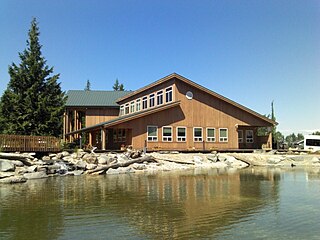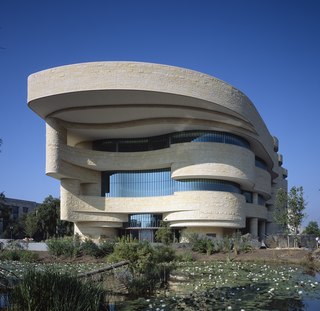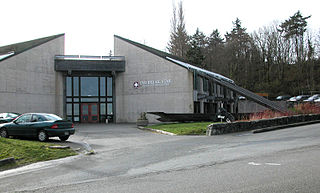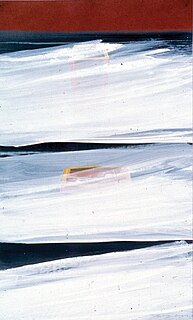Education and early career
Jones was born in Okmulgee, Oklahoma (headquarters of the Muscogee (Creek) Nation) to a Welsh-born father and a Choctaw/Cherokee mother. Neither parent had more than a grade school education. His parents marriage had largely ended by the time he was 9 years old, and he and his mother moved to Manteca, California under an Indian relocation program. In Oklahoma, he had been instructed in Native American traditions by his maternal grandmother; in California (Manteca and later Stockton) he lived in a largely Hispanic environment and at times did farm work, which was his mother's occupation. [1]
Although he did poorly in school other than excelling in art classes and physical education, he managed to graduate from high school in 1959, and attended San Jose City College. A job as an office boy at architecture firm Higgins & Root in San Jose, combined with his drawing skills set him on the first steps of his career. With help from his boss Chester Root he entered the University of Oregon in Eugene, Oregon, where for the first time he became a serious student, and where he began his interest in Native American architecture, more neglected in the U. of O. curriculum of the time than not. He continued to work summers at Higgins & Root. [1]
After graduating in 1967, he moved in Seattle, working briefly for Paul Thiry, then at Dersham & Dimmick, before opening a practice on Bainbridge Island. He became increasingly involve in Native American matters, joining the Urban Indian Committee, where he first came to know Native activist Bernie Whitebear. In the early 1970s, he met landscape architect Grant Richard Jones (no relation), who was studying the Native American burial mounds of the Midwest. In 1973, he joined Grant Jones and Grant's then-wife Ilze Jones at Jones & Jones, based in the Globe Building in Seattle's Pioneer Square neighborhood. [1]

The Squaxin Island Indian Reservation is a Native American tribal government in western Washington state in the United States. The Squaxin Island Tribe is made up of several Lushootseed clans living along several inlets of southern Puget Sound:

The Suquamish are a Lushootseed-speaking Native American people, located in present-day Washington in the United States. They are a southern Coast Salish people. Today, most Suquamish people are enrolled in the federally recognized Suquamish Tribe, a signatory to the 1855 Treaty of Point Elliott. Chief Seattle, the famous leader of the Suquamish and Duwamish Tribes for which the City of Seattle is named, signed the Point Elliot Treaty on behalf of both Tribes. The Suquamish Tribe owns the Port Madison Indian Reservation.

The National Museum of the American Indian is a museum in the United States devoted to the culture of the indigenous peoples of the Americas. It is part of the Smithsonian Institution group of museums and research centers.

The Daybreak Star Indian Cultural Center is a Native American cultural center in Seattle, Washington, described by its parent organization United Indians of All Tribes as "an urban base for Native Americans in the Seattle area." Located on 20 acres in Seattle's Discovery Park in the Magnolia, Seattle, Washington Magnolia neighborhood, the center developed from activism by Bernie Whitebear and other Native Americans, who staged a generally successful self-styled "invasion" and occupation of the land in 1970. Most of the former Fort Lawton military base had been declared surplus by the U.S. Department of Defense. "The claim [Whitebear and others made] to Fort Lawton was based on rights under 1865 U.S.-Indian treaties promising reversion of surplus military lands to their original owners."
George Hargreaves is a landscape architect. Under his design direction, the work of his firm has received numerous national awards and has been published and exhibited nationally and internationally. He was an artist in residence at the American Academy of Rome in 2009. Hargreaves and his firm designed numerous sites including the master plan for the Sydney 2000 Olympics, The Brightwater Waste Water Treatment Facility in Seattle, Washington, and University of Cincinnati Master Plan.

The National Museum of the American Indian–New York, the George Gustav Heye Center, is a branch of the National Museum of the American Indian in Manhattan, New York City. The museum is part of the Smithsonian Institution. The Center features contemporary and historical exhibits of art and artifacts by and about Native Americans.

Richard Haag was an American landscape architect. He worked on Gas Works Park in Seattle, Washington and on the Bloedel Reserve on Bainbridge Island. He founded the Landscape Architecture Program at the University of Washington and held multiple design awards. Richard Haag's modernist and minimalist ideals set the tone for northwestern landscape design.
DakshinaChitra is a living-history museum in the Indian state of Tamil Nadu, dedicated to South Indian heritage and culture. It is located 25 kilometres (16 mi) to the south of Chennai. Opened to the public on 14 December 1996, the museum was founded and is being managed by the Madras Craft Foundation (MCF). The MCF was established in 1984. Deborah Thiagarajan, an Indian art historian of American origin, governs the museum. The museum is built on 10 acres (4.0 ha) of land taken on a 33-year lease from the Government of Tamil Nadu. Located at Muttukadu, on the East Coast Road connecting Chennai and Pondicherry, the site overlooks Bay of Bengal.
Grant Richard Jones is an American landscape architect, poet, and founding principal of the Seattle firm Jones & Jones Architects, Landscape Architects and Planners. In more than four decades of practice, his work in ecological design has garnered widespread recognition for its broad-based and singular approach, one that is centered on giving voice to the land and its communities. Called the “poet laureate of landscape architecture” Jones's poetry informs his designs.

Brad Cloepfil is an American architect, educator and principal of Allied Works Architecture of Portland, Oregon and New York City. His first major project was an adaptive reuse of a Portland warehouse for the advertising agency Wieden+Kennedy. Since 2000, Cloepfil and Allied Works have completed cultural, commercial and residential projects including the Contemporary Art Museum St. Louis, the University of Michigan Museum of Art, the Dutchess County Residence Guest House and the Museum of Arts and Design. Recent and notable works include the Clyfford Still Museum in Denver, Colorado, completed in November 2011, and the National Music Centre of Canada in Calgary, Alberta, which opened in July 2016.
Mithun is a multidisciplinary design firm headquartered in Seattle with offices in San Francisco and Los Angeles. The company provides integrated design services including architecture, landscape architecture, interior design, urban design and planning.

Ron Wigginton is an American artist and landscape architect. His paintings and sculptures are found in West Coast museums and many private collections. His landscapes are known for their narrative and aesthetic qualities, and his artwork typically involves and explores human perceptions of natural and built landscapes. Wigginton is considered to be one of the first Landscape Architects to approach the design of a landscape as a conceptual work of art, for which he has received international recognition through publication and awards.
AldrichPears Associates is an interpretive planning and exhibit design firm based in Vancouver, British Columbia, Canada. They work for museums, science centers, interpretive centers, zoos, aquariums, botanical gardens, and children's museums around the world. AldrichPears Associates is best known for designing the exhibits at the Desert Living Center at the Las Vegas Springs Preserve, Nevada, a LEED-certified project that explores sustainable living in the desert and the Museo del Acero, a steel museum housed in a restored blast furnace, at Parque Fundidora. This museum interprets the scientific and cultural history of steelmaking in Mexico.
The Suquamish Museum preserves and displays relics and records related to the Suquamish Tribe, including artifacts from the Old Man House and the Baba'kwob site. It is located on the Port Madison Indian Reservation in Washington state and was founded in 1983. The museum currently occupies a facility opened in 2012.

The Bainbridge Island Japanese American Exclusion Memorial is an outdoor exhibit commemorating the internment of Japanese Americans from Bainbridge Island in the state of Washington. It is located on the south shore of Eagle Harbor, opposite the town of Winslow. Administratively, it is a unit of the Minidoka National Historic Site in Idaho. The mission of the memorial is Nidoto Nai Yoni, “Let It Not Happen Again”.

Lois Jane Hastings, often known as L. Jane Hastings, is an American architect, a Fellow of the American Institute of Architects and the first woman to serve as chancellor of the AIA College of Fellows. Her architecture firm, the Hastings Group, designed over 500 mostly residential buildings in the Seattle area.

The architecture of Seattle, Washington, the largest city in the Pacific Northwest region of the U.S., features elements that predate the arrival of the area's first settlers of European ancestry in the mid-19th century, and has reflected and influenced numerous architectural styles over time. As of the early 21st century, a major construction boom continues to redefine the city's downtown area as well as neighborhoods such as Capitol Hill, Ballard and, perhaps most dramatically, South Lake Union.
Shannon Nichol is an American landscape architect and founding principal of Gustafson Guthrie Nichol (GGN), located in Seattle. Nichol has led many of GGN's landscape design projects including the designs for Boston's North End Parks, Seattle's Bill & Melinda Gates Foundation campus, and San Francisco's India Basin Shoreline. In 2018, she was elected a member of the National Academy of Design in the category "Architecture."

The Vancouver Land Bridge connects Vancouver Waterfront Park to the Vancouver, Washington portion of the Fort Vancouver National Historic Site using a path similar to an ancient Native American trail. The bridge, which spans Highway 14, has been described as "the most visible part of the larger" Confluence Project.
David Hancocks is a British architect and designer for zoos, natural history museums, botanic gardens, and nature centers. Notable for overseeing the creation of the Woodland Park Zoo's revolutionary gorilla exhibit, which for the first time utilized mature trees natural foliage merged seamlessly for both the animals and the visitors. The technique was dubbed a landscape immersion exhibit, and has become the often imitated standard for accredited zoos across the globe.












